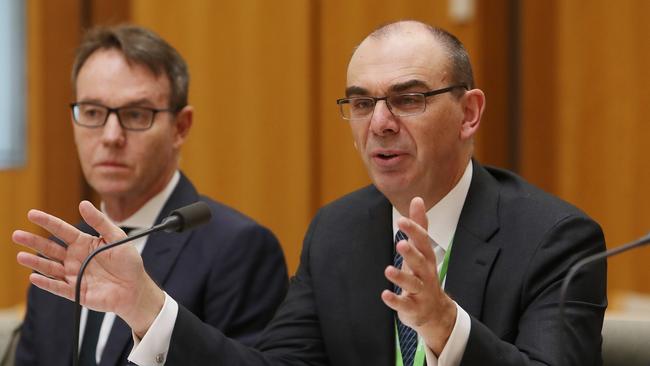APRA sounds warning bell about ‘very different’ housing market
Australia is entering a ‘very different’ housing environment compared to the last decade, APRA warns.

The prudential regulator has warned that Australia is entering a “very different” housing environment compared to the last decade, with borrowers coming off ultra-low fixed rates facing a possible repayment shock and negative equity in their homes.
Australian Prudential Regulation Authority chairman Wayne Byres said dollar losses from housing portfolios now regularly exceeded those from other portfolios in APRA stress tests.
“Of course, that can simply be a product of the calibration of the stress test itself, but more intuitively it reflects the combination of a growing proportion of housing loans in the total book, and rising risks within those portfolios from a larger share of more heavily indebted borrowers,” Mr Byres told a conference.
The APRA chief’s warning came as ANZ Bank chief executive Shayne Elliott said the underlying cause of rising interest rates was a strong economy.
“The economy is sort of on fire; it’s doing really well,” Mr Elliott told an Australia-Israel Chamber of Commerce lunch in Melbourne.
“That’s why we have inflation and labour shortages - a lot of it is demand-led, so the Reserve Bank is trying to take money out of the system to slow demand.
“The issue here will be their ability to do that well, and it’s really hard for them to judge the right level of interest rates in an environment like this because there are so many moving parts.”
Housing loans make up a touch more than 60 per cent of the banking industry’s total loan portfolio.
Portfolios have traditionally been low-risk, with large credit losses mostly coming from elsewhere, notably from corporate lending and commercial property.
But now, the faster-than-expected emergence of higher inflation and interest rates is likely to have a significant impact on many mortgage borrowers.
Mr Byres said pockets of stress were likely, particularly if interest rates rise quickly and housing prices fall.
APRA had therefore been “increasingly exercised” - and sometimes interventionist - in recent years about the quality of housing lending, and its proposed new macroprudential framework had a big focus on measures to constrain housing-related risks.
“Of particular note will be residential mortgage borrowers who took advantage of very low fixed rates over the past couple of years, and may face a sizeable ‘repayment shock’ (possibly compounded by negative equity) when they need to refinance in the next year or two,” the APRA chief said.
“We will also be watching closely the experience of borrowers who have borrowed at high multiples of their income – a cohort that has grown notably over the past year.
“Interestingly, this growth has not been an industry-wide development, but rather has been concentrated in just a few banks.
“We therefore opted to tackle our concerns on a bank-by-bank basis, rather than opt for any form of macroprudential response.”
Lending policy changes were expected at these banks, and coupled with rising interest rates, the level of high debt-to-income borrowing was projected to moderate in the period ahead.
Overall, the banking industry was “well-placed” to weather a more difficult environment, and any deterioration in housing loan portfolios was not expected to cause system stability issues.
Also, the expected decline in housing prices was, on balance, a positive development from a stability perspective, reducing the need for borrowers to borrow very high multiples of their incomes.
On climate, Mr Byres said APRA had recently surveyed 64 medium-to-large firms, including 21 of the largest banks, about its prudential practice guide on the financial risks of climate change.
An important finding, he said, was that “only around half” the banks surveyed were currently assessing emissions from their lending exposures.
This created two challenges.
“First, it makes it difficult for banks to properly understand how borrowers will (or will not) be impacted by the transition to a lower carbon world,” Mr Byres said.
“And second, it makes it difficult for banks to satisfy the increasing demands from investors, standard-setters and peer regulators for greater climate risk disclosure.”
As an example, both the International Sustainability Standards Board and the US Securities and Exchange Commission had released draft disclosure standards in recent months about the role of Scope 3 - or indirect - emissions as part of a more comprehensive disclosure framework.
The APRA chief said the international investor community was demanding greater transparency about climate-related risks and opportunities, and greater sophistication in response to what they saw as poor climate risk management.
There was a strong preference for more active engagement and shareholder advocacy rather than divestment.
On Anthony Albanese’s plan for an employment summit, Mr Elliott said the issue the nation faced was a lack of workers, with wages growth yet to show in the official data.
“I remember the same conversations a year ago when inflation kept reporting really low and everybody would say they were seeing cost problems in their business.
“Everybody I talk to, including us, says they are facing higher wage costs; we are having to pay people more to retain them.
“It seems pretty obvious to me that wages are heading north and we‘ll see it coming into the data soon.”





